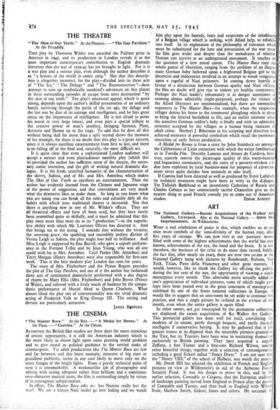ART
WHAT a real celebration of peaCe is this, which enables us to see once more symbols of -the semi-divinity of the human race, after five years of carnage. We can now visit at our pleasure rooms filled with some of the highest achievements that the world has ever known, achievements of the eye, the hand and the brain. It is not. therefore, the business of the critic to do more than record, baldly, the fact that, after nearly six years,, there are now two roans at the National Gallery hung with pictures by Rembrandt, Rubens, Van Eyck, Titian, Piero della Francesca and other great masters. would, however, like to thank the Gallery for offering the public, during the last year of the war, the opportunity of viewing a single masterpiece every month. This admirable move actually added to one's appreciation of individual pictures, some of which' might per- haps have been passed over-in the great concourse of masterpieces exhibited by one of the finest national collections in Europe. would like to suggest that an ante-room be ,set aside to continue this practice, and that a single picture be isolated as the picture of the month, even when the entire gallery is again filled.
In other rooms, not _yet reoccupied by the permanent collection, are displayed the recent acquisitions of the Walker Art Gallery. This provincial gallery has done well for itself, considering the modesty of its means, partly through bequest, and partly through intelligent if conservative buying. It. may be gathered that it has greater means at its disposal than the miserable pittance granted to the Tate, but its Trustees have been wise in -restricting themselves exclusively to British painting. They have acquired a superb Zoffany, a fine Turner and afirst-rate Richard Wilson, among other beautiful things, together with a selection of contemporaries,
including a good Sickert called "Fancy Dress." I am not sure that the "Henry VIII," of the school of Holbein, was- worth the money Mr. Derek Hill has selected the exhibition of French and English pictures on view at Wildenstein's in aid of the Airborne Forces
Security Fund. It was his design to prove in this, and in his earlier selection, Constable to Cizanne, that the European tradition of landscape painting moved from England to France after the deaths
of Constable and Turner, and then back to England with Wilson Steer; Mathew Smith, Sickert, Innes and others. He succeeds. in
hat the best English paintings of the present century hang as per- ectly equal in quality to their French, and more expensive, counter- arts. The juxtaposition of Rousseau and Christopher Wood, of Ivon Hitchens and Soutine, of Utrillo and a particularly fine Paul Nash, is of extraordinary interest, and it is heartening to note that the English do not give ground. A particularly ingenious juxta- position of a Victor Pasmore and a Whistler contrives to discourage easy allusions to the "great old days." There is little to chose be- tween these two excellent and closely allied pictures. The Wave is one of Pasmore's best works, completely successful except in the sky, which is somewhat streaky, exceptionally delicate, and in its own way first class. It is, however, no use dragging out an obscure Victorian, one Cecil Lawson, to try and bolster up the reputation of English painting in the 1850's. His picture is both dully and flashy, at one and the some time. Also it proves nothing to hang it next to a bad Graham Sutherland.
MICHAEL AYRTON.



























 Previous page
Previous page